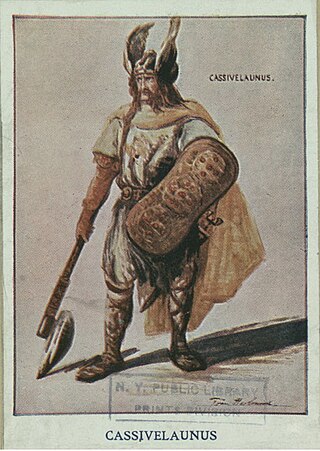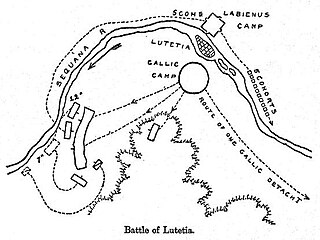Related Research Articles

The Nervii were one of the most powerful Belgic tribes of northern Gaul at the time of its conquest by Rome. Their territory corresponds to the central part of modern Belgium, including Brussels, and stretched southwards into French Hainault. During their first century BC Roman military campaign, Julius Caesar's contacts among the Remi stated that the Nervii were the most warlike of the Belgae. In times of war, they were known to trek long distances to take part in battles. Being one of the northerly Belgic tribes, with the Menapii to the west, and the Eburones to their east, they were considered by Caesar to be relatively uncorrupted by civilization. According to Tacitus they claimed Germanic descent. According to Strabo they were of Germanic origin.

The Battle of the Sabis, also known as the Battle of the Sambre or the Battle against the Nervians, was fought in 57 BC near modern Saulzoir in Northern France, between Caesar's legions and an association of Belgae tribes, principally the Nervii. Julius Caesar, commanding the Roman forces, was surprised and nearly defeated. According to Caesar's report, a combination of determined defence, skilled generalship, and the timely arrival of reinforcements allowed the Romans to turn a strategic defeat into a tactical victory. Few primary sources describe the battle in detail, with most information coming from Caesar's own report on the battle from his book, Commentarii de Bello Gallico. Little is therefore known about the Nervii perspective on the battle.
The Atrebates were a Belgic tribe of the Iron Age and the Roman period, originally dwelling in the Artois region.

The Cantiaci or Cantii were an Iron Age Celtic people living in Britain before the Roman conquest, and gave their name to a civitas of Roman Britain. They lived in the area now called Kent, in south-eastern England. Their capital was Durovernum Cantiacorum, now Canterbury.

The Bellovaci were a Belgic tribe dwelling in the modern Picardy region, near the present-day city of Beauvais, during the Iron Age and the Roman period. After they were defeated by Caesar in 57 BC, they gave lukewarm support to the Gallic revolt led by Vercingetorix in 52 BC. The Bellovaci nonetheless organized resistance against Rome in 51 BC.

Cassivellaunus was a historical British military leader who led the defence against Julius Caesar's second expedition to Britain in 54 BC. He led an alliance of tribes against Roman forces, but eventually surrendered after his location was revealed to Julius Caesar by defeated Britons.

Commius was a king of the Belgic nation of the Atrebates, initially in Gaul, then in Britain, in the 1st century BC.

The Pictones were a Gallic tribe dwelling south of the Loire river, in the modern departments of Vendée, Deux-Sèvres and Vienne, during the Iron Age and Roman period.
Imanuentius is named in some manuscripts of Julius Caesar's De Bello Gallico as a king of the Trinovantes, the leading nation of south-eastern Britain at that time, who ruled before Caesar's second expedition to the island in 54 BC. Variant spellings include Inianuvetitius, Inianuvetutus and Imannuetitius. In other manuscripts this king's name is not given.
Mandubracius or Mandubratius was a king of the Trinovantes of south-eastern Britain in the 1st century BC.
Segovax was one of the four kings of Kent during Julius Caesar's second expedition to Britain in 54 BC, alongside Cingetorix, Carvilius and Taximagulus. The four were allies of the British leader Cassivellaunus, and attacked the Roman naval camp in an attempt to relieve him when he was besieged by Caesar in his stronghold north of the Thames. However the attack failed and Cassivellaunus was forced to seek terms.
The Ancalites were a tribe of Iron Age Britain in the first century BCE. They are known only from a brief mention in the writings of Julius Caesar. They may have been one of the four tribes of Kent, represented in Caesar by references to the "four kings of that region" and in the archaeological record by distinct pottery assemblages.
The Segontiaci were a tribe of Iron Age Britain in the first century BCE. They are known only from a brief mention in the writings of Julius Caesar. They may have been one of the four tribes of Kent, represented in Caesar by references to the "four kings of that region" and in the archaeological record by distinct pottery assemblages.

In the course of his Gallic Wars, Julius Caesar invaded Britain twice: in 55 and 54 BC. On the first occasion Caesar took with him only two legions, and achieved little beyond a landing on the coast of Kent. The second invasion consisted of 800 ships, five legions and 2,000 cavalry. The force was so imposing that the Britons did not dare contest Caesar's landing, waiting instead until he began to move inland. Caesar eventually penetrated into Middlesex and crossed the Thames, forcing the British warlord Cassivellaunus to surrender as a tributary to Rome and setting up Mandubracius of the Trinovantes as client king.
Cingetorix was one of the four kings of Kent during Caesar's second expedition to Britain in 54 BC, alongside Segovax, Carvilius and Taximagulus. The four were allies of the British leader Cassivellaunus, and attacked the Roman naval camp in an attempt to relieve him when he was besieged by Caesar in his stronghold north of the Thames. However the attack failed and Cassivellaunus was forced to seek terms.
The Cenimagni were a tribe of Iron Age Britain in the first century BCE. They are known only from a brief mention in the writings of Julius Caesar. It has been suggested that the name is a variant of Iceni with the Latin adjective magni, meaning "great". Others have suggested that they may have been one of the four tribes of Kent, represented in Caesar by references to the "four kings of that region" and in the archaeological record by distinct pottery assemblages.
The Cassi were a tribe of Iron Age Britain in the first century BCE. They are known only from a brief mention in the writings of Julius Caesar. They may have been one of the four tribes of Kent, represented in Caesar by references to the "four kings of that region" and in the archaeological record by distinct pottery assemblages.

The Parisii were a Gallic tribe that dwelt on the banks of the river Seine during the Iron Age and the Roman era. They lived on lands now occupied by the modern city of Paris, whose name is derived from the ethnonym.

The Ambarri were a Gallic people dwelling in the modern Ain department during the Iron Age and the Roman period.

The Battle of Lutetia was a battle on the plain of Grenelle in what is now Paris between Roman forces under Titus Labienus and an anti-Roman Gallic coalition in 52 BC during the Gallic Wars. It was a Roman victory.
References
- ↑ Julius Caesar, Commentarii de Bello Gallico 5.21
- ↑ Barry Cunliffe, Iron Age Communities in Britain, fourth edition, Routledge, 2005.
- ↑ Sergent, Bernard (1991). "Ethnozoonymes indo-européens". Dialogues d'histoire ancienne. 17 (2): 10. doi:10.3406/dha.1991.1932.
- ↑ Julius Caesar, Commentarii de Bello Gallico 5.17-23